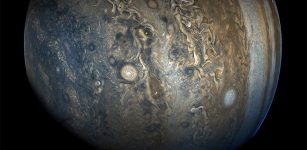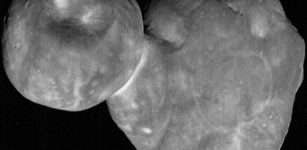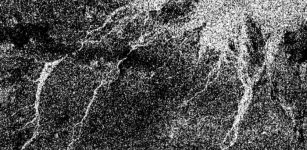Clouds Spotted On Distant Exoplanet WASP-127b
Eddie Gonzales Jr. – MessageToEagle.com – An international team of astronomers has not only detected clouds on the distant exoplanet WASP-127b, but also measured their altitude with unprecedented precision. A presentation by Dr. Romain Allart at the Europlanet Science Congress (EPSC) 2021 shows how, by combining data from a space- and a ground-based telescope, the team has been able to reveal the upper structure of the planet’s atmosphere. This paves the way for similar studies of many other faraway worlds.
WASP-127b, located more than 525 light-years away, is a “hot Saturn”—a giant planet similar in mass to Saturn that orbits very close to its sun. The team observed the planet passing in front of its host star to detect patterns that become embedded in the starlight as it is filtered through the planet’s atmosphere and altered by the chemical constituents. By combining infrared observations from the ESA/NASA Hubble Space Telescope (HST) and visible light measurements from the ESPRESSO spectrograph at the European Southern Observatory’s Very Large Telescope in Chile, the researchers were able to probe different regions of the atmosphere. The results brought a few surprises.
Some of the elements making WASP-127b unique, compared with the planets of our Solar System. Credit: David Ehrenreich/Université de Genève, Romain Allart/Université de Montréal.
‘First, as found before in this type of planet, we detected the presence of sodium, but at a much lower altitude than we were expecting. Second, there were strong water vapor signals in the infrared but none at all at visible wavelengths. This implies that water-vapor at lower levels is being screened by clouds that are opaque at visible wavelengths but transparent in the infrared,’ said Allart, of the iREx/Université de Montréal and Université de Genève, who led the study.
The combined data from the two instruments enabled the researchers to narrow down the altitude of the clouds to an atmospheric layer with a pressure ranging between 0.3 and 0.5 millibars.
‘We don’t yet know the composition of the clouds, except that they are not composed of water droplets like on Earth,’ said Allart. ‘We are also puzzled about why the sodium is found in an unexpected place on this planet. Future studies will help us understand not only more about the atmospheric structure, but about WASP-127b, which is proving to be a fascinating place.’
With a full orbit around its star occurring in about four days, WASP-127b receives 600 times more irradiation than the Earth and experiences temperatures up to 1100 degrees Celsius. This puffs the planet up to a radius 1.3 times larger than Jupiter, with just a fifth of the mass, making it one of the least dense or “fluffiest” exoplanets ever discovered.
The extended nature of fluffy exoplanets makes them easier to observe, and thus WASP-127b is an ideal candidate for researchers working on atmospheric characterisation.
The team’s observations with the ESPRESSO instrument also suggests that, unlike planets in our Solar System, WASP-127b orbits not only in the opposite direction than its star but also in a different plane than the equatorial one.
‘Such alignment is unexpected for a hot Saturn in an old stellar system and might be caused by an unknown companion,’ said Allart. ‘All these unique characteristics make WASP-127b a planet that will be very intensely studied in the future.’
The Echelle SPectrograph for Rocky Exoplanets and Stable Spectroscopic Observations (ESPRESSO) is the world’s most precise spectrograph for radial velocity measurements, a method enabling to detect exoplanets.
The authors would like to acknowledge Dr. Jessica Spake and her team for releasing the refined HST data used in this work.
Written by Eddie Gonzales Jr. MessageToEagle.com Staff











